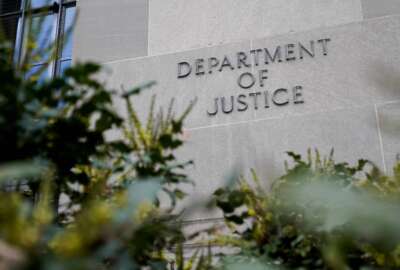How the immigration court dockets look from the judges’ point of view
We just heard the macro view of how the immigration situation is cascading down to the Justice Department's immigration courts.
We just heard the macro view of how the immigration situation is cascading down to the Justice Department’s immigration courts. For how it looks from the inside, Federal Drive with Tom Temin turned to the president of the National Association of Immigration Judges, Mimi Tsankov.
Interview Transcript:
Tom Temin And first of all, what is the status of the union itself? Because there was a battle, if I recall, over your existence.
Mimi Tsankov Right now, we are just in association because we are not recognized as the collective bargaining unit for the Department of Justice after we were decertified by the Federal Labor Relations Authority. We’re in the process of fighting to regain that status.
Tom Temin Right. That was a different Federal Labor Relations Authority membership roster than it is now.
Mimi Tsankov That is true. But there’s been a nominee presented for the third open position on the FLRA board, and that person has not gone through the congressional review process yet. We are anxiously awaiting that completion.
Tom Temin Got it. That could be on hold for six more years too.
Mimi Tsankov No, don’t say that.
Tom Temin Let’s hope not. Anyway, to the matter at hand, we just heard Don Kerwin in his report on just the cascading numbers of cases piling up that he said there’s no way humanity can get it done with the number of judges there are and the resources you have. And you were part of that report. So tell us the background of how that came to be, and then we’ll get a sense of what it looks like from a judge’s standpoint.
Mimi Tsankov Thank you so much for allowing me to talk about this topic. I felt very fortunate to work with Donald Cohen in his capacity as executive director of the Center for Migration Studies in New York, because he is truly a leader in trying to understand, and dig deep on what the problems are they’re facing the entire system. My focus, as along with a couple of other immigration judges speaking in their capacity, was to give him the inside look at the immigration courts. And some of the areas where we focused, where were concerns about lack of access to resources. That is a continuing problem that’s been one that we’ve seen in multiple administrations and a number of different Congresses. Oftentimes insufficient resources to deal with the volume of work pending before us. And that can be, it’s not just new judges that we need. More judges isn’t just the answer, you need to have the whole entourage that supports an entire judicial system. So we always advocate for judge team hiring, not just judges.
Tom Temin And what are the other functions on a judge team?
Mimi Tsankov A legal assistant, to make sure that the hearing notices go out in a timely manner, that documents that have just been filed are properly attached to the file and ready for the trial when the hearing goes forward. Interpreters, judicial law clerks and security for the courthouse as it expands.
Tom Temin Got it. And what is the backlog situation now? Because you see on cable TV endless debates about the immigration and what’s going on at the border. Is the result, though, that there is a growing case log of immigrants that need to have their cases heard by the courts.
Mimi Tsankov The answer is yes. But there’s also an interesting side note and nuance to that I’ll point out. So the current number that we read on track, the Syracuse reporting system, is that we’re at about 2.4 million cases in our backlog currently pending at the immigration courts nationwide. But what track also reports is that the speed at which the immigration judges are completing cases is faster than it’s ever been. So it’s one of these races you can’t outrun the volume of numbers of cases that appear before us.
Tom Temin Right. The only way to get it all done is to say, well, just take this whole stack and run it through an approval stamp or disapproval stamp. Clearly, that’s not judgment. That’s just simply process. And so how do you speed up things? Because as much as it may look like it’s just an undifferentiated mass of people coming to the country. Each case, I’m thinking, is probably unique.
Mimi Tsankov I think part of what impacts the extent to which we’re able to complete cases more quickly is the degree to which you have the Department of Homeland Security opposing resolutions. When there is greater prosecutorial discretion on the part of the Department of Homeland Security that improves outcomes in terms of our ability to more quickly move through cases that are currently pending.
Tom Temin We are speaking with Mimi Tsankov. She is president of the National Association of Immigration Judges. But the backlog is growing, and given the rate at which they are on average going through the courts and what’s happening in the backlog, will you ever get through this workload?
Mimi Tsankov We know that the ultimate solution is to create an independent immigration court. And the Center for Migration Studies article and study led to that conclusion as well. And why would that be helpful? It is helpful for a number of different reasons. First of all, the endemic problem that is at the root of the backlog and the challenges facing the court is this lack of judicial independence. Why does that matter? Because every new administration that comes in has different priorities that they want the judges to focus on, and those priorities are constantly shifting. As a result, one attorney general will say the law is set up A, B, and C. This is the governing precedent that will decide how the immigration judges decide the cases. Then you get a change of the administration and the new attorney general says, no, it’s going to be D, E, and F. And so the parties that have appeared before the court then have a lot of cases already on appeal. All those cases have to be resent to the immigration judge to be reopened and relitigated under the new standards that have just been issued. It’s this constant, I call it sort of a churning of the docket. And the other aspect to it is what we call docket shuffling. When we have a new issue of new cases, new priorities of cases coming close to the border. Not surprisingly, the administration will say, let’s focus on this set of problems right now. But what happens to my other docket that is currently pending before me in my home court? Well, that docket just essentially languishes because there’s nobody else to pick it up. So that’s where you get this constant churn and growth in the backlog.
Tom Temin And refresh our memory on how many immigration judges there are under justice.
Mimi Tsankov We have about 700 nationwide at about 70 courts around the country. And there’s an additional 50 or so judges that are the supervisory judges. They have some responsibilities to preside, but the vast majority of their duties are to manage these 70 courts around the country and the judges that preside at them.
Tom Temin So I’m doing a little quick math here, let’s see. So if you’ve got 2.4 million cases, I’m doing this live here, and you divide by 700 judges, that means you’ve got 3,428 and a half cases per judge. How fast can you do a case? And then you can multiply, it just seems insurmountable.
Mimi Tsankov It is an enormous amount of work. So when I calculated that out, I figured out that if I wanted to try to finish that amount of work, I think I came up with it would take me spending only an hour and a half per case and never taking a vacation, never having a sick day. It would take a few years to just go through what is currently pending before the court, and we know that’s not reasonable. There’s no way you can only spend an hour and a half on these cases from like soup to nuts from beginning to end. They have multiple hearings, they’re witnesses, and due process requires a more in-depth review. So it is insurmountable. We need to be looking at solutions like the Center for Immigration Studies has been doing and proposing changes. We’re hopeful that Congress will look at solutions and consider an independent immigration court as one of those solutions.
Tom Temin And the result of this is that when DHS says, OK, yes, you can come to America and you can get your hearing. And meanwhile you’re off into the country, it could be five, six years then before that trial actually takes place. And a lot can happen to a family and to a nation in those five or six years.
Mimi Tsankov It’s exactly right. From one perspective, it’s justice delayed is justice denied. But I think it also has this sense within the public that we are not really doing not only right by the people that are appearing before us, but also not right by the country, because they have an expectation that our courts are going to work efficiently and resolve cases in an expeditious manner. And they are disappointed when we can’t. But the reality is we’ve been given an extremely difficult job and we’re working, as I mentioned, harder, faster than we’ve ever worked before. We even work weekends now.
Tom Temin Wow.
Mimi Tsankov All of our cases.
Tom Temin And here we complain when like a country like India takes six months to approve a visa or something. What is the morale of you and your fellow judges here?
Mimi Tsankov Well, I would say that the morale is low and there’s actually documented proof of that. The federal government does a survey every year about what is morale, and how a management is functioning. And we have, unfortunately, as an agency have been near the bottom of that. I know that the agency is working to try to improve morale. They are suggesting a lot of different ways to address the various concerns. But I think part of what leads to low morale is the fact that we just don’t have a robust labor management relationship and communication system. And I say that because, for example, you mentioned at the outset that our union has been disbanded and we no longer have that fully, robust occasion to talk about all the issues that are currently pending before the courts as a whole. I think that the agency would do well to reinvigorate those kind of conversations to improve the relationship.
Tom Temin Has Merrick Garland ever called up and said, Mimi, I feel your pain?
Mimi Tsankov He has not, but I suspect I’m an eternal optimist. I’m sure he does feel my pain.
Copyright © 2025 Federal News Network. All rights reserved. This website is not intended for users located within the European Economic Area.
Tom Temin is host of the Federal Drive and has been providing insight on federal technology and management issues for more than 30 years.
Follow @tteminWFED






